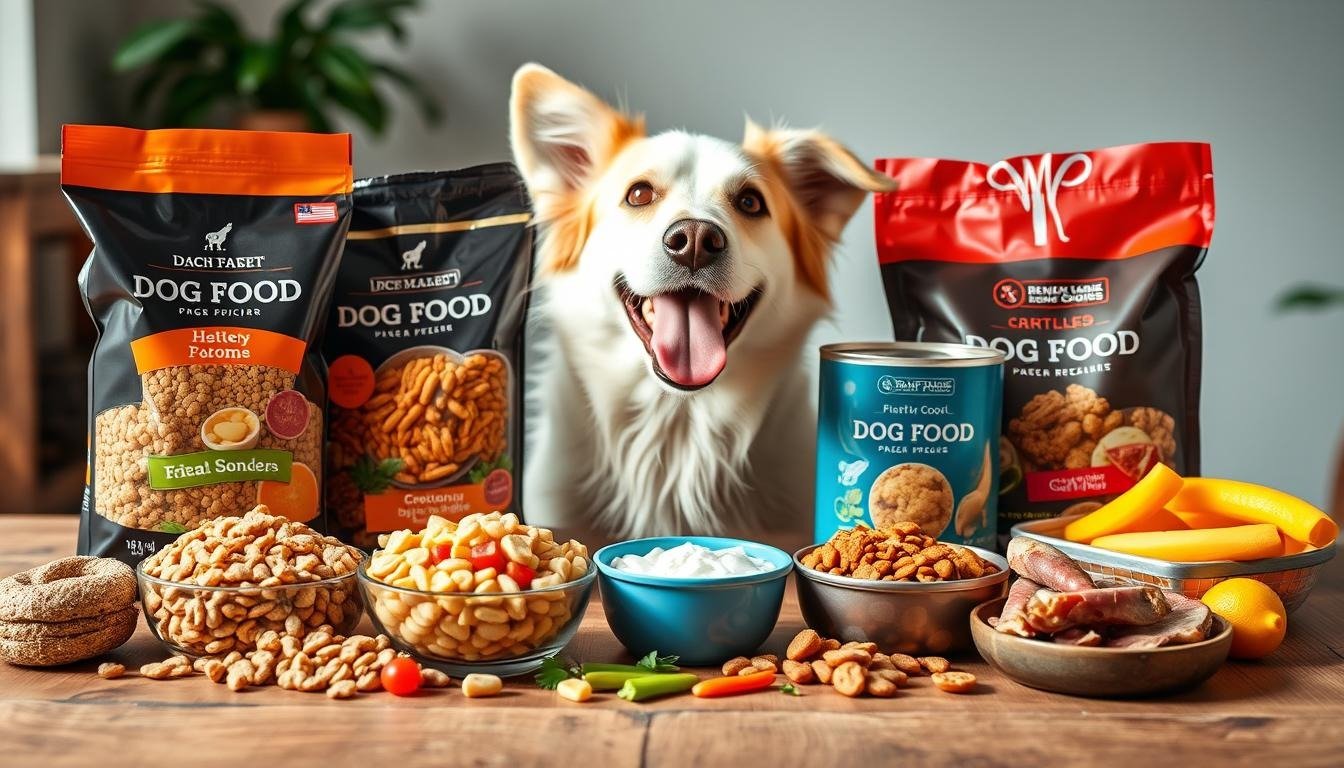Our dogs rely on us for their food and care. Many pet owners ask, “How long can a dog go without food?” This guide will tell you how long a dog can survive without eating. It also covers the signs of hunger and starvation, and the dangers of not eating enough.
Knowing what our dogs need to eat is crucial for their health. By understanding this, we can keep them safe and avoid emergencies.

Key Takeaways
- Dogs have specific nutritional needs that vary by size, age, and health status.
- The duration a dog can survive without food depends on various factors, including their overall health and stored body fat.
- Recognizing the early signs of hunger and starvation is crucial for the well-being of your canine companion.
- Prolonged food deprivation can lead to severe health consequences, including organ failure and death.
- Seeking prompt veterinary care is essential if your dog is experiencing signs of malnutrition or starvation.
Understanding the Basics of Canine Nutrition
Keeping a dog healthy is all about their diet. As pet owners, knowing what nutrients they need is key. It’s also important to understand how much food they should eat and when.
Essential Nutrients for Dog Health
Dogs need a mix of proteins, carbs, fats, vitamins, and minerals to stay healthy. Proteins help build and repair muscles. Carbohydrates give them energy, and fats keep their skin and coat healthy. Vitamins and minerals boost their immune system and help their bones and organs grow right.
Daily Caloric Requirements by Size and Age
The food a dog needs changes with their size, age, and how active they are. Smaller dogs eat less than big ones, and puppies need more than older dogs. Knowing how many calories your dog needs helps prevent dog malnutrition and keeps them at a healthy weight.
The Role of Regular Feeding Schedules
Having a regular feeding time is vital for a dog’s health. It helps them digest food better and keeps their metabolism steady. It also stops dog feeding frequency problems and makes sure they get all the nutrients they need. Sticking to a schedule also lets you keep an eye on how much they eat and spot any digestion or appetite issues.
“A well-balanced, nutritious diet is the foundation of a dog’s overall health and well-being.”
How Long Can a Dog Go Without Food
Dogs can survive without food for different lengths of time. The average dog can last 3 to 5 days without eating. But, this can change based on the dog’s age, size, health, and where they live.
Puppies and older dogs are more at risk of starvation. They need more food and can’t handle going without as well as healthy adult dogs. Larger dogs also have a shorter time without food because they need more energy. Smaller dogs and those in better shape might last a bit longer.
| Dog Size | Estimated Survival Without Food |
|---|---|
| Small Breeds (under 20 lbs) | 5-7 days |
| Medium Breeds (20-50 lbs) | 3-5 days |
| Large Breeds (over 50 lbs) | 2-4 days |
These are just rough estimates. A dog’s actual time without food can be affected by many things. These include if they have water, the temperature, and their health. It’s very important for dog owners to never stop feeding their dogs on purpose. If a dog looks like it’s starving or dehydrated, get it to a vet right away.
“Depriving a dog of food for an extended period can have severe consequences, both in the short and long term. It’s essential to ensure your furry friend has access to proper nutrition at all times.”
Signs of Hunger and Starvation in Dogs
Knowing the signs of hunger and starvation in dogs is crucial. These signs can impact their health and happiness. It’s important for pet owners to watch for these warning signs closely.
Physical Symptoms of Malnutrition
Dogs without enough food may show several physical signs. These include:
- Significant weight loss and visible ribs, spine, or hip bones
- Dull, dry coat and excessive shedding
- Sunken eyes and dehydration
- Lethargy and weakness
- Digestive issues such as vomiting or diarrhea
Behavioral Changes During Food Deprivation
Dogs facing dog starvation risks may also change their behavior. These changes can be:
- Increased begging or scavenging for food
- Aggression or increased defensive behaviors around food
- Obsessive or destructive behaviors related to food
- Decreased activity levels and loss of interest in play
Emergency Warning Signs
If a dog shows severe dog emergency food deprivation symptoms, get help fast. Signs like extreme lethargy, seizures, or unresponsiveness are serious. They need immediate vet care.
Knowing the signs of hunger and starvation helps keep dogs healthy. Pet owners can take steps to ensure their dogs stay well-fed and happy.
Factors Affecting a Dog’s Survival Without Food

Several key factors influence a dog’s ability to survive without food. Knowing these can help us understand how resilient our dogs are.
The breed and size of a dog are crucial. Smaller dogs, like toy and miniature breeds, have a harder time without food. They can get very weak quickly. On the other hand, larger dog breeds and working dogs can go longer without eating. This is because they have stronger bodies and more energy.
A dog’s age also matters. Puppies and older dogs are more at risk when they don’t eat. Their bodies are still growing or are slowing down with age.
A dog’s overall health condition is another important factor. Dogs with health issues, like diabetes or kidney disease, need to eat more often. This helps keep them healthy.
The environment where a dog lives also affects its survival. Things like temperature, humidity, and access to water can help or hurt a dog without food. It depends on the situation.
Understanding these factors helps pet owners plan for their dog’s needs. This way, they can make sure their dogs are ready for any food shortages or emergencies.
Health Risks of Food Deprivation in Dogs
Proper nutrition is key for a dog’s health. The dangers of not feeding them enough are huge. Prolonged dog starvation harms vital organs and overall health.
Short-term Effects on Dog Health
Dogs without food face many health problems right away. They might feel very tired, have weaker immune systems, and struggle with digestion. In bad cases, they could face serious issues like electrolyte imbalances and organ failure.
Long-term Consequences of Starvation
Long-term dog malnutrition prevention brings even bigger problems. Dogs might miss out on important nutrients like protein, vitamins, and minerals. This can slow their growth, weaken their bones, and make them more likely to get sick.
Impact on Vital Organs
Not eating enough can really hurt a dog’s organs. The liver, kidneys, and heart are specially at risk. This can lead to serious organ problems or even failure, needing quick vet help.
It’s important to know the dog starvation risks and stop dog malnutrition early. By understanding these dangers, we can make sure our dogs get the food they need to stay healthy.
Safe Fasting Periods for Different Dog Breeds
Knowing how long dogs can fast is crucial for pet owners. The fasting time varies by size, metabolism, and breed. Finding a balance between fasting and feeding is essential for a dog’s health.
Small dogs like Chihuahuas and Yorkies need to eat often. They can’t go long without food. On the other hand, big dogs like Labradors and Great Danes can fast for a day or two if they’re healthy.
Some dogs, like Greyhounds and Whippets, burn energy fast. They need to eat more to stay energetic. Breeds like Pugs and French Bulldogs also need special care when fasting because of their breathing issues.
| Dog Breed | Recommended Fasting Duration |
|---|---|
| Chihuahua | 4-6 hours |
| Labrador Retriever | 12-24 hours |
| Greyhound | 8-12 hours |
| Pug | 6-8 hours |
| Great Dane | 18-24 hours |
Remember, these are just guidelines. Every dog is different. Owners should watch their dogs closely and talk to a vet to find the best feeding plan.
Good pet owners focus on their dog’s nutrition. They make sure their dogs eat well to stay healthy. Knowing how long dogs can fast helps owners care for their pets better.
Emergency Nutrition Solutions for Dogs

When a dog is in an emergency and can’t eat regular food, it’s key to have a plan. The right emergency food can greatly help a dog’s health and survival during tough times.
Temporary Food Alternatives
If your dog can’t have their usual food, there are some temporary options:
- Cooked chicken or turkey (without bones or skin)
- Boiled eggs
- White rice mixed with plain yogurt or cottage cheese
- Canned tuna or salmon (in water, not oil)
- Sweet potatoes or pumpkin (cooked and mashed)
These human foods can give your dog the nutrients they need until you can get their regular food. But, introduce these foods slowly and in small amounts to avoid stomach problems.
Reintroducing Food After Fasting
When your dog can eat again, it’s important to do it slowly and carefully. Eating too much too soon can cause serious health issues, like refeeding syndrome. Here’s how to safely start eating again:
- Start with small, frequent meals of easy-to-digest foods.
- Slowly increase the amount and frequency of meals over a few days.
- Watch your dog for any signs of stomach upset or other health problems.
- Talk to your vet if you’re worried about how to start eating again.
With a plan for emergency food and careful refeeding, you can help your dog stay healthy during dog emergency food deprivation.
When to Seek Veterinary Care
In cases of dog emergency food deprivation or dog starvation risks, knowing when to seek vet care is key. Dogs can go without food for a bit, but long-term fasting is dangerous. It can lead to serious health problems that need vet help right away.
Watch for these signs that mean your dog needs vet care fast:
- Rapid weight loss or emaciation
- Extreme lethargy or weakness
- Persistent vomiting or diarrhea
- Dehydration and electrolyte imbalances
- Organ dysfunction, such as liver or kidney issues
- Neurological symptoms like disorientation or seizures
If your dog shows any of these dog starvation risks, call your vet immediately. Quick medical care can prevent serious damage and help your dog recover fully.
Conclusion
We’ve learned how crucial good food and regular meals are for dogs. We’ve discovered the essential nutrients they need and how to spot hunger and starvation. A dog’s health greatly depends on getting enough to eat.
The time a dog can skip meals varies based on their breed, age, and health. But, the risks of not eating enough are always there. Not eating for too long can harm a dog’s body and mind, putting their health at risk.
As pet owners, we must focus on our dogs’ food needs. We should ensure they get a balanced diet. By having emergency food plans and proper storage, we can keep our dogs safe from how long can a dog go without food and canine starvation timeline. A happy, healthy dog is one that’s well-fed.
FAQ
How long can a dog go without food?
How long a dog can go without eating depends on several things. These include the dog’s size, age, health, and where it lives. A healthy adult dog can usually go 3-5 days without food. But, this time can change a lot.
It’s very important to make sure your dog eats again soon. This is to avoid serious health problems.
What are the signs of hunger and starvation in dogs?
Signs of not eating enough in dogs include losing weight and feeling very tired. They might also have a dull, dry coat. You might see them begging more, acting aggressively, or sleeping a lot differently.
But, if your dog loses weight fast, gets very dehydrated, or shows signs of organ failure, get them to the vet right away. These are emergency signs.
What are the health risks associated with food deprivation in dogs?
Not eating for a short time can cause low blood sugar, imbalances in electrolytes, and a weak immune system. But, not eating for a long time can really hurt a dog’s body.
It can damage the heart, liver, and kidneys. This can even lead to death. It’s very serious.
How can I ensure my dog’s nutritional needs are met?
To make sure your dog eats well, feed them regularly and give them a balanced diet. Keep some extra food ready, just in case. Watch your dog’s weight, how they look, and how they act.
If you notice anything off, talk to your vet. They can give you advice that’s just right for your dog.
When should I seek veterinary care for a dog that is not eating?
If your dog hasn’t eaten in more than 24 hours, or if they show signs of hunger or starvation, see a vet right away. Not eating for too long can cause big health problems.
Your vet can help your dog get better. They will give them the care they need to stay healthy.
